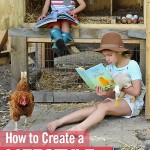
When you homeschool, your whole approach to learning starts to change. You may begin to look at nearly everything as a learning opportunity. That newfound perspective doesn’t mean you drag an encyclopedia to the playground. But it does mean you've discovered that learning new things is exciting! You stop and wonder and talk about the world around you. And your kids soak it up. You begin to create a lifestyle of learning.
If you grew up bored in school, be prepared for your kids to have a very different experience—a wonderful experience—with this lifestyle of learning! We all know that children who love to learn will absorb far more wisdom and knowledge than children who think they hate school.
So besides using a fascinating curriculum like Sonlight, what else can you do to help your children love to learn? Here are pictures of what a lifestyle of learning could look like. You probably see your own family in these portrayals. But you may find a few new ways to create a unique lifestyle of learning in your home.
(And don’t worry—no one does all of these things all the time. They’re simply ideas to spur your own imagination.)
Read out loud.
Read out loud with your kids when they’re young and after they learn to read. Nothing opens up the world for them quite like an adventure to another time or place, snuggled up with mom or dad on the couch.
Help your kids love to read on their own.
Better to help your children learn to love reading at their own pace than to make it such a chore that they grow to hate it. (Read about how this worked out for one my sons who struggled with the mechanics of reading.)
Answer why with why.
When your child asks a why question, see if you can turn it around and ask what she thinks the answer could be. When you help her discover the answer, it’s more satisfying to everyone, and often gets more at the heart of what she wanted to know in the first place.
Stop and marvel at nature with your children.
If you are outside and a giant flock of geese flies overhead, you might stop, bend down to your kids’ level and watch in awe. That might lead into a conversation about the migration patterns of geese, or it might not, but either way it feeds your children’s natural awe at God’s creation.
Include your children in housework.
If you have the time and the patience as you do your housework, slow down to a kid’s pace and let your children help you as much as possible even if it takes much longer that way.
Try new foods.
Let your child pick out a new fruit or vegetable to try when you’re at the grocery store. Or better yet, let them choose some seeds to plant a new flower, herb, or vegetable in your backyard.
When you learn about a different culture, consider trying some food from that culture, whether you cook it yourself, browse a grocery store from that culture, or go out to eat.
Listen to good music in your home.
Listen to your favorites, but also try new genres you don’t often hear, such as Jazz, Broadway, Gregorian chant, Bluegrass, and a variety of Classical music. (Sonlight does carry some classical albums to help you here.)
Have conversations around the dinner table.
Talk about what your children learned during dinner. Show them that both their parents are excited about what they’re learning.
Ask your child for input.
Ask your child periodically if there is anything he’d like to learn about or something he’d like to learn to do. Then help him brainstorm how to make that happen.
Pursue your own interests.
Learn new things that you want to learn. Let your children see this process and know that you are learning, too.
Talk. Really talk.
When you children ask you a tricky question (about sexuality or evil, for example), take them seriously and give them a real answer. Try to listen and figure out what they’re asking and what they want to know. Set yourself up as the place to go when they have questions that feel too big for them.
Make connections.
Make connections between things you’ve learned in various books and different subjects. When you notice something you’ve learned about in a new context, point it out to your children.
Play!
Give your children plenty of unstructured play time both indoors and outdoors. Behind reading, this might be the most important thing you can do to help them learn! There are countless benefits to letting your kids get enough physical and imaginative exercise.
Invest in art supplies.
Provide access to art supplies, even if you only bring out the messier ones at designated art times.
When you travel, take time to learn about where you are.
Whether you go to visit a cave, visit a museum, or read a piece of historical fiction about the place, enjoy the chance to see something new!
Provide tools for their interests.
Give your children basic tools to pursue their interests (or help them earn money to buy such tools). For our children, this meant a musical instrument and a swimsuit for each child, a basic video camera for Luke, some art supplies and lessons for Jonelle, and plenty of social opportunities for Justin. Amy just needed plenty of books and free time!
How has your family moved toward learning in all parts of life? What lifestyle of learning components are the most meaningful for you? Take note and treasure those special moments together!








Thanks for sharing! I like these ideas and how easy they are to implement. Plus I just love the title image with the chickens!